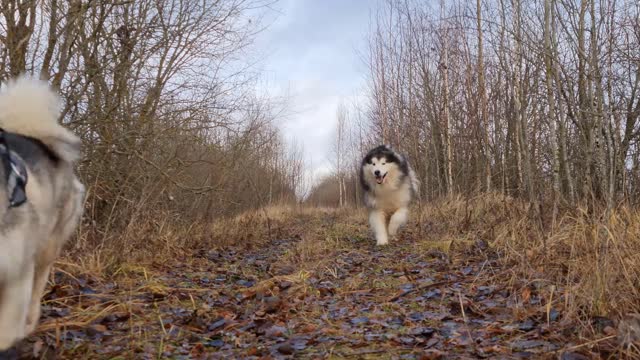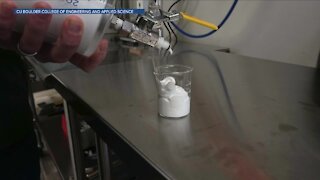Premium Only Content

Identification of sniffer dogs from samples of patients with COVID-19 - a pilot study.
Identification of sniffer dogs from samples of patients with COVID-19 - a pilot study.
The ongoing COVID-19 pandemic highlights the importance of rapid and reliable testing for accurate identification of symptomatic and asymptomatic carriers to effectively reduce the spread of infection . Current testing regimens generally require nasopharyngeal swabs applied by a trained person and a reverse transcription polymerase chain reaction (RT-PCR) test to identify the pathogen. Obtaining RT-PCR results is time consuming and can be cost prohibitive, especially for developing countries, and therefore it is currently often used in a targeted manner, predominantly testing patients with specific symptoms of COVID-19 . There is therefore a need for a more rapid, reliable, non-invasive, and versatile additional screening tool, especially for identifying asymptomatic and pre-symptomatic individuals.
Several studies prove the extraordinary olfactory acuity of canines to detect people with infectious and non-infectious diseases such as different types of cancer , malaria , bacterial and viral infections , with sensitivity and specificity rates . A pathogen-specific odor that can be detected by dogs can be composed of specific patterns of volatile organic compounds (VOCs). Compared to bacteria, viruses do not have their own metabolism and therefore VOCs are released by infected body cells as a result of metabolic processes of the host . Different technical approaches have used VOC detection to successfully discriminate infectious diseases, but none are being used routinely in clinical practice . As dogs can be trained quickly, the aim of the present study was to test the concept of using dogs reliably and in real time to discriminate between samples from SARS-CoV-2 infected patients and uninfected controls. This method can be employed in public areas such as airports, sporting events, borders, or other crowds as an alternative or addition to laboratory testing, thus helping to prevent the spread of the virus or new outbreaks.
Saliva and tracheobronchial secretion samples were collected from hospitalized COVID-19 patients who had clinical symptoms and were diagnosed as positive for SARS-CoV-2 using nasopharyngeal swab samples. Negative control samples were obtained from SARS-CoV-2 RT-PCR negative individuals with no previous history of COVID-19, nor did the individuals have a history of a recent cold or infection. None of the samples were screened for different human coronaviruses, such as beta coronavirus HCoV-OC43 or alpha coronavirus HCoV-229E. After sample acquisition, the anonymized samples were transported to the University of Veterinary Medicine Hannover .
All collected samples were confirmed as positive or negative using the RT-PCR SARS-CoV-2-IP4 assay from the Institut Pasteur (recommended by the World Health Organization , including an internal control system and protocol as described . Samples from COVID-19 patients (regardless of the final RT-PCR result) were further subjected to virus quantification (endpoint dilution assay) and virus isolation analysis using Vero E6 cells under biosafety level 3 conditions. Cell layers were evaluated for cytopathic effects and final results were obtained 7 days after cellular infection. Since dogs are susceptible to SARS-CoV-2 all samples from COVID-19 patients were inactivated with beta propiolactone (BPL) to protect the dogs and their handlers from infection during training. Briefly, the samples and reagents were kept at 4°C, 20 μl/ml NaHCO 3(7.5%) was added and the samples were incubated for 10 min at 4°C. After 10 μl/ml of 10% GLP was added, the samples were incubated at 4°C for 70 to 72 h. BPL hydrolysis was conducted at 37°C for 1 to 2 h. Samples that showed a cytopathic effect before GLP inactivation using virus isolation or endpoint dilution assay were retested after GLP inactivation and were confirmed as inactivated. Only inactivated GLP samples from COVID-19 patients were used for the dog training. In addition, detection dogs were given negative control samples with and without prior treatment with GLP to exclude hydrolyzed GLP as a potential distraction reagent.
After a 2-week habituation process to DDTS, the eight dogs required 5 days of training in total until the detection rate was above chance.
The detection dogs were able to discriminate respiratory secretions from SARS-CoV-2 infected individuals from those of healthy controls with high sensitivity and specificity rates.
-
 0:58
0:58
KMGH
3 years agoMicrobubbles could help COVID-19 patients & others with ARDS
801 -
 2:50
2:50
KSHB
2 years agoDoctors weigh in on patients diagnosed with both COVID-19, flu
24 -
 2:19
2:19
KNXV
2 years agoAlzheimer's study recruiting patients
211 -
 0:59
0:59
Reuters
2 years agoCOVID-19 can cause brain shrinkage: study
47914 -
 3:47
3:47
WXYZ
2 years agoAscension Macomb has new technology to help patients with blood clots from COVID-19
16 -
 10:17
10:17
Dermatologist Dr. Dustin Portela
2 days ago $1.21 earnedOlay Cleansing Melts: Dermatologist's Honest Review
154K14 -
 1:02:20
1:02:20
Trumpet Daily
2 days ago $47.93 earnedObama’s Fake World Comes Crashing Down - Trumpet Daily | Dec. 20, 2024
110K68 -
 6:29
6:29
BIG NEM
1 day agoCultivating God Mode: Ancient Taoist NoFap Practices
80.4K20 -
 30:53
30:53
Uncommon Sense In Current Times
2 days ago $0.86 earned"Pardon or Peril? How Biden’s Clemency Actions Could Backfire"
91.9K10 -
 40:01
40:01
CarlCrusher
1 day agoSkinwalker Encounters in the Haunted Canyons of Magic Mesa - ep 4
83.8K10